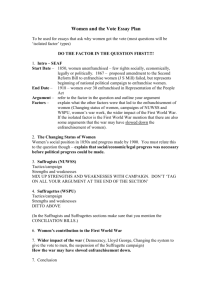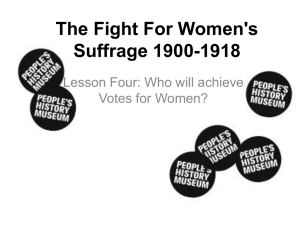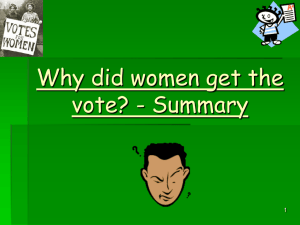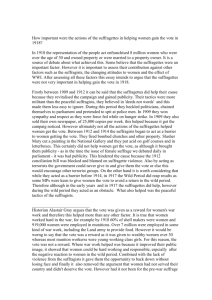Paper 2 Notes Votes for Women
advertisement
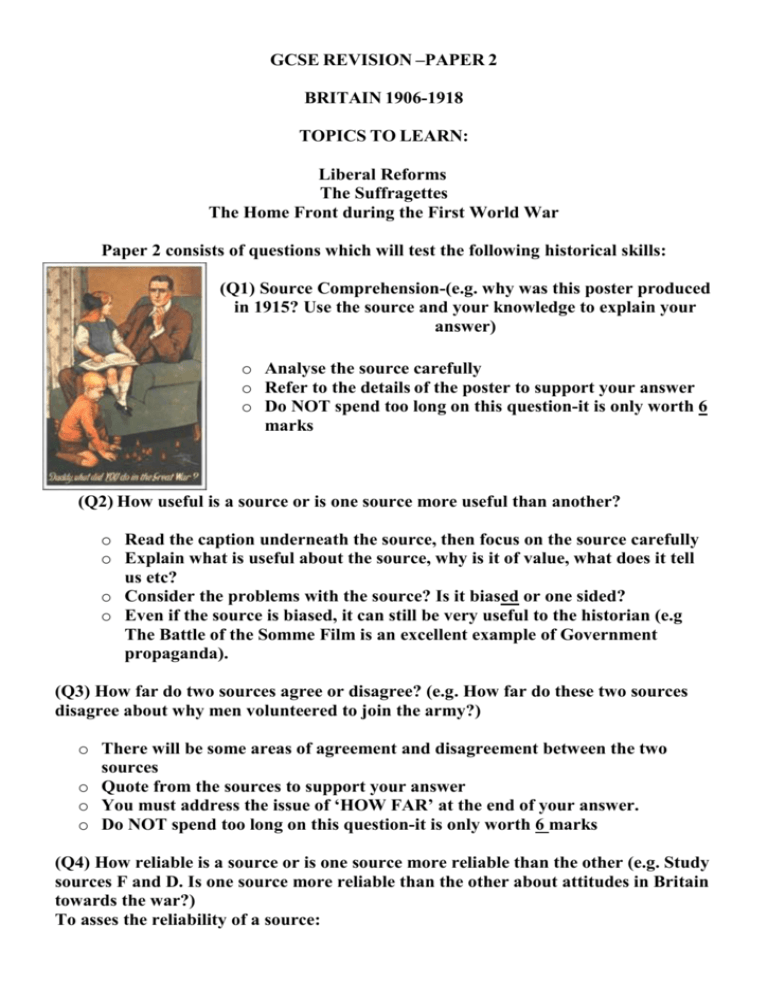
GCSE REVISION –PAPER 2 BRITAIN 1906-1918 TOPICS TO LEARN: Liberal Reforms The Suffragettes The Home Front during the First World War Paper 2 consists of questions which will test the following historical skills: (Q1) Source Comprehension-(e.g. why was this poster produced in 1915? Use the source and your knowledge to explain your answer) o Analyse the source carefully o Refer to the details of the poster to support your answer o Do NOT spend too long on this question-it is only worth 6 marks (Q2) How useful is a source or is one source more useful than another? o Read the caption underneath the source, then focus on the source carefully o Explain what is useful about the source, why is it of value, what does it tell us etc? o Consider the problems with the source? Is it biased or one sided? o Even if the source is biased, it can still be very useful to the historian (e.g The Battle of the Somme Film is an excellent example of Government propaganda). (Q3) How far do two sources agree or disagree? (e.g. How far do these two sources disagree about why men volunteered to join the army?) o There will be some areas of agreement and disagreement between the two sources o Quote from the sources to support your answer o You must address the issue of ‘HOW FAR’ at the end of your answer. o Do NOT spend too long on this question-it is only worth 6 marks (Q4) How reliable is a source or is one source more reliable than the other (e.g. Study sources F and D. Is one source more reliable than the other about attitudes in Britain towards the war?) To asses the reliability of a source: o o o o o o o o Always read the caption underneath first Consider: who wrote it When it was written Why it was written Is it fact or opinion Comparison Read carefully and closely the content of each source Come to a well judged conclusion (Q5) Why do sources disagree? (e.g. Study sources G and H. Why do these sources give different views of what it was like in the trenches?) o Again read the caption underneath each source. o Consider the N O P (Nature, Origins and Purpose) of each source: o Nature: What is it? (e.g. is it an advertisement, extract from a speech/book or a photograph) o Origins: When was it produced? o Purpose: Why was it produced? o Come to a judgement about WHY not HOW the sources disagree. (Q6) The final question requires you to study all the sources and use your own knowledge. (e.g. Study all the sources. ‘Men volunteered for the army because they thought it would be an adventure’ Using the sources and your own knowledge how far do you agree with this statement? o This final question is worth 12 marks! Make sure you leave enough time to answer this question properly, you should spend about 25 minutes on this! o Write a quick plan in rough o Ensure you use both the sources and your own knowledge. If you do not, you will lose half of the marks available. o Try to group the sources around the key question, do they agree or disagree with the statement, or do they offer a different perspective? o Select some brief quotes to show how they agree or disagree o Include your own knowledge o Address the How far part of the question. VOTES FOR WOMEN REVISION TIME LINE Peaceful campaigning Actions of Campaigners Since 1860s – there were early campaigners for the vote for women known as suffragists 1897 – Millicent Fawcett sets up the National Union of Women’s Suffrage Societies (NUWSS) What else was happening? Up to 1900 Parliament received 15 bills to give women the vote and 15 times it failed. Direct Action Begins 1903 – Emmeline Pankhurst founds the Women’s Social and Political Union (WSPU) who became known as suffragettes. June 1908 – Direct Action Begins. Following a march, suffragettes SMASH WINDOWS in Downing Street and chain themselves to railings 1907, 1908, 1909 see introduction of suffrage bills that fail. October 1908 – Emmeline Pankhurst and her daughter Christabel are sent to PRISON. 1908 – Herbert Asquith becomes Prime Minister. He is against votes for women. Late 1908 – Millicent Fawcett and the Suffragists reject the violent tactics of the Suffragettes and a split between the NUWSS and the WSPU begins. 1909 – More Suffragettes sent to prison. Some go on HUNGER STRIKE. Government respond by FORCE-FEEDING. Violence Intensifies 1910 – WSPU calls a truce while ‘Conciliation Bill is introduced’. When it fails, the Suffragette protests turn into BLACK FRIDAY where police physically and sexually assault protesters. 1911 – Another truce over the ‘Conciliation Bill’ which again breaks down. 1910 – A ‘CONCILIATION BILL’ is introduced to give the vote – it is abandoned 1911 – The ‘Conciliation Bill’ is reintroduced but not supported by the government. 1912 – It fails 1912 – MASSIVE CAMPAIGN of window smashing. WSPU headquarters are raided. Mass hunger strikes take place in prisons. 1913 CAT AND MOUSE Act to release hunger-strikers when 1913 – Violence increases – BOMBINGS, BURNINGS, they were ill and rearrest them when better. LETTER BOXES DESTROYED, RACE COURSES VANDALISED. June 1913 – Emily Davison kills herself by running out in front of the King’s horse at the Derby 1914 – WSPU violence escalates and public opinion is firmly against them. The War Sept 1914 – Both movements stop activities and help the war effort 1915 the WSPU organised the ‘Women’s Right to Serve’ march, renamed their newspaper Britannica and changed the name of their organisation to the Women’s Party. The suffragettes also insisted that conscription was introduced and handed out white feathers to men not in military uniform. Sylvia Pankhurst, a pacifist opposes the war. The NUWSS helped the war effort by setting up an employment register and recruiting many men to replace the women who had gone to the front. The NUWSS continue to campaign for the vote. Sept 1914 Outbreak of war 1915-the government considers changing the electoral system to allow soldiers serving abroad to vote. 1916 Women show themselves to be capable and responsible by taking over men’s’ jobs after conscription is introduced. 1917-The House of Commons passes the Representation of the People Act. All men over the age of 21 and women over the age of 30 gain the vote and the right to become MPs. 1918 the Representation of the People Act becomes law. Out of an electorate of 21 million, 8 million were women. Britain 1906-1914 Revision Notes Votes for Women What were the arguments for and against female suffrage? The vote will improve men’s moral and sexual behaviour. Benefits Women have special skills and expertise. They can help parliament make better laws on issues such as education and the home where they are specialists. Entitlement Arguments for Female suffrage Women could already vote in local elections. They serve on local government bodies, such as education committees and Poor Law boards. They have shown they can be trusted with the vote. Parliament’s decisions affect both men and women. Voting is a ‘right’ to which women are entitled. Women have had increasing opportunities in education and workParliament’s decisions affect both men and the vote should cometonext. women. Voting is a ‘right’ which women are entitled. Women pay taxes just like men they should be allowed to influence MPs on how that money is spent. Britain is not a true democracy until women have the vote. By 1914 women had the vote in many other countries including the USA, New Zealand, parts of Australia and the Isle of Man. Giving respectable women the vote would also encourage them to develop their careers and neglect their family duties. It was believed that women were guided more by their womb than their brain. Women were seen as too emotional to be trusted with the vote. Women and men had separate spheres. Women were suited to the private sphere as home-makers and mothers. Many women did not want the vote. Only a small fraction of women joined the various suffrage societies Unsuitable As it was mainly middle class women who campaigned for the vote, opponents of female suffrage claimed these women would have little interest in laws to help ordinary working people. Arguments against Female suffrage Not entitled The existing political Other problems system in Britain worked well. Allowing women the vote could upset the stability of the whole system. As women could not fight in the army or navy, some argued that they did not deserve the vote. How effective were the activities Activities The NUWSS campaigned for the vote using peaceful methods. They put pressure on parliament, issued petitions and organised meetings. The WSPU used both peaceful and illegal methods of campaign known as militancy. They aimed to make women’s suffrage an issue which the government could not ignore. A women getting arrested for the cause was front page news whereas processions and of the suffragists and the suffragettes? Effectiveness By 1900 the NUWSS had achieved some success by gaining the support of many Liberal MPS, some Conservative MPS and the new Labour Party. However, neither the Conservative nor Liberal Party was prepared to adopt female suffrage as party policy, so it never got priority in parliament. The government dealt with protesters harshly with protesters and initially responded to hunger striking by force-feeding. This was a painful experience and generated some sympathy from the general public. However, the suffragettes despite their efforts did petitions could be ignored. Suffragettes attacked property and people and when arrested went on hunger strike as a protest against the authorities refusal to treat them as political prisoners. not succeed in winning over the press and majority of men in the country. To opponents of female suffrage militancy appeared to confirm the idea that women were too emotional to be trusted with the vote. Militancy also created divisions within the votes for women movement. As violence increased after 1908 the NUWSS publicly opposed the actions of the suffragettes as they felt their actions were putting off moderate MPS who might otherwise back their cause. Did the violent methods of the suffragettes help? Yes No Violence gave the government an excuse not to Female suffrage became front page news and it give in to the suffragettes. They could argue it was was brought to the attention of the public and the wrong to give into violence. government. Decades of suffragists campaigning had achieved The violence turned moderate men, especially nothing but empty promises from MPS. moderate MPs, against the ideas of votes for women. This explains why bills in the house of commons were always defeated. The government only became more serious about The violence seemed to confirm the view that passing a female suffrage bill after militancy had women were not responsible enough to have the started. vote. They were too hysterical. Asquith was already firmly against votes for In 1913 and 1914, the NUWSS was growing in women, so violent methods did not make things popularity at the expense of the WSPU. any worse. As women actively challenged the separate spheres Increased militancy divided the moment after 1908, idea by taking to the streets and campaigning, the when the NUWSS began to oppose violent methods idea of women having the vote no longer seemed so of campaign. strange. People were gradually getting used to the idea and beginning to accept it. How did women contribute to the war effort? 1914 1915 1916 Both suffrage organisations (WSPU and NUWSS) helped the government in recruiting and organising women workers. All suffragettes were released from prison. Members of the WSPU worked to persuade men to join the army and distributed white feathers to men not in uniform. Women started to work in munitions factories. This was tiring and dangerous work often resulting in the yellowing of the skin, digestion problems, blood poisoning and even brain damage. After conscription was introduced, many women took over the jobs left vacant by men serving at the front. Women occupied many different jobs working as: bus conductors, postal workers, grave diggers, road layers, welders, steel workers and bus drivers. A Women’s Volunteer Police Service was set up in most of the major cities. Overall 1.6 million women took part in war work. 1918 The first Women’s Army Unit was formed (the Women’s Army Auxiliary Corps WAAC), although women were not involved in front line fighting. However, many women worked as nurses in medical station near the front line. Why were some women given the vote in 1918? The vote was won because of war work The vote was won because of campaigns before the war The war gave MPS a convenient The government were worried excuse to give up their opposition that the Suffragettes would restart to votes for women. The war their campaign. work had destroyed many of their arguments. Many men were impressed by women’s contribution to the war effort. They had shown they were mature, sensible and capable. The argument that women could not take part in the defence of their country had been destroyed. The vote was won because of other reasons Lloyd George replaced Asquith as Prime Minster in 1916. He was more sympathetic to the idea of votes for women. Reform of the existing system was needed because of soldiers who had lost the right to vote by being abroad for a long time. This became an opportunity to include women’s rights. Conservative MPs were glad women under 30 would not get the vote. They had feared that young working class women would vote Labour. Liberal and Labour MPS were glad all women over 30 were getting the vote. This meant that working class, as well as middle and upper class women could vote, so they would not all vote Conservative. Political Parties’ attitudes towards votes for women Conservative Party View Although there was more opposition to it among the Conservatives, as was perhaps to be expected, a number of leading Conservatives supported it, including the party leader, Balfour. Labour Party View The Labour Party supported the suffrage movement and leading figures such as Kier Hardie were deeply involved in the issue. Liberal Party View A substantial section of the Liberal Party, quite possibly the majority, supported it, as did many leading Liberals, including Churchill, Lloyd George, and Sir Edward Grey.

